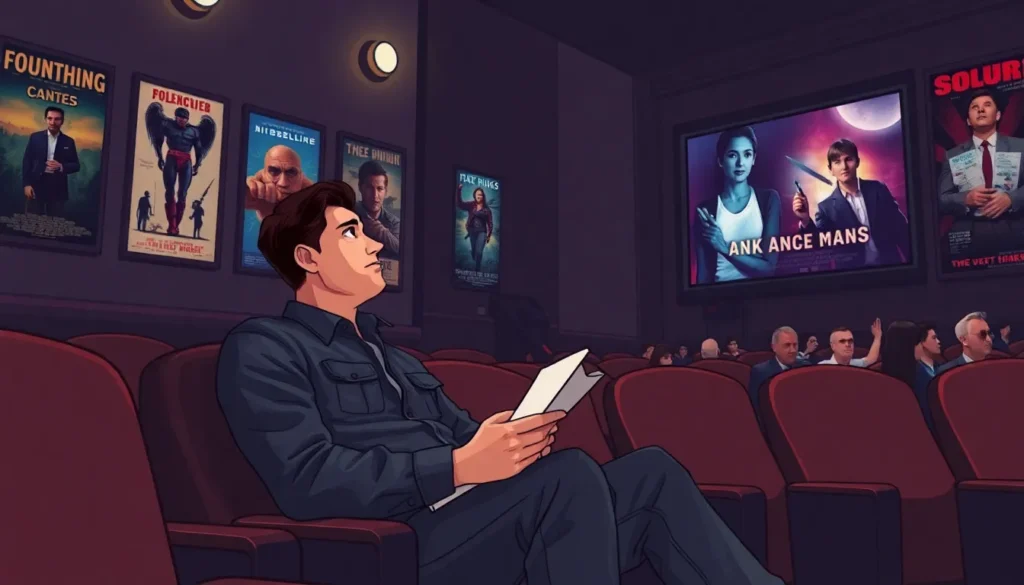Ever walked out of a movie theater scratching your head, wondering if you just witnessed cinematic genius or an elaborate prank? You’re not alone. Movie endings often leave audiences baffled, debating plot twists and hidden meanings long after the credits roll. It’s like trying to solve a Rubik’s Cube while blindfolded—frustrating yet oddly satisfying.
In this guide, we’ll dive into the murky waters of movie endings to unravel the mysteries that left viewers puzzled. Whether it’s a mind-bending thriller or a heartwarming drama, understanding the conclusion can transform your viewing experience from “What just happened?” to “Aha! Now it makes sense!” So grab your popcorn and let’s decode those perplexing finales together. You might just find that the ending you thought was a flop is actually a cleverly crafted masterpiece.
Table of Contents
ToggleImportance Of Movie Endings
Movie endings play a crucial role in shaping audience experiences. They often serve as the final impression a viewer takes away from the film. An effective ending can add depth and meaning, tying together various plot threads while enhancing emotional impact. Many viewers reflect on how an ending resonates with their overall understanding of the film.
Endings can also stimulate discussion among fans. When a conclusion is ambiguous or thought-provoking, it encourages analytical conversations. Engaging in dialogue helps clarify different interpretations and allows viewers to connect with others who share their interests. Additionally, a well-crafted ending often brings satisfaction, providing closure and resolution that viewers seek.
Understanding the importance of endings can transform a viewer’s approach to storytelling. Rather than viewing a conclusion as simply a wrap-up, they can appreciate the narrative choices behind each story. Filmmakers invest significant time in crafting endings to align with themes and character development, resulting in memorable cinematic moments.
Various genres utilize endings differently. Action films may rely on explosive conclusions while romantic comedies often provide feel-good resolutions. By recognizing these patterns, viewers can enhance their film appreciation. Exploring diverse cinematic techniques illustrates how endings contribute to a film’s identity.
Heeding the significance of movie endings transforms the viewing experience. Instead of dismissing a confusing conclusion, audiences can delve deeper into the storytelling elements. This analytical lens brings richer insights into emotional arcs and overall narrative success.
Common Themes In Movie Endings

Movie endings often embody recurring themes that influence audience interpretation. Commonly, these themes can signify deeper messages or provoke thought and discussion.
Open-Ended Conclusion
Open-ended conclusions leave viewers with lingering questions, inviting speculation. Characters may not resolve their conflicts neatly, allowing for various interpretations. This ambiguity can serve a purpose, encouraging audiences to reflect on the characters’ journeys. Many filmmakers utilize this technique to promote discussions about themes and character motivations. Films like “Inception” exemplify this approach, prompting debates about reality and dreams. Ultimately, open-ended conclusions enhance viewer engagement, extending the film’s impact beyond the credits.
Plot Twists
Plot twists dramatically alter audience perceptions, adding layers to storytelling. Directors often deploy unexpected turns to challenge viewer assumptions and keep them engaged. Major reveals can redefine character motivations or story arcs, creating significant emotional responses. Thrillers and dramas frequently feature this technique, enhancing suspense and interest. For example, films like “The Sixth Sense” deliver shocking twists that invite revisiting earlier scenes for context. Ultimately, plot twists maintain excitement and encourage viewers to reassess their understanding of the narrative.
Analyzing Movie Endings
Movie endings significantly impact viewer understanding, allowing for a deeper appreciation of narrative completion. Characters, themes, and visual elements often intertwine, leading viewers to rich interpretive experiences.
Character Development
Character arcs often resolve in meaningful ways during endings. Transformations reveal the depth of a character’s journey, highlighting struggles and achievements. For example, in “The Shawshank Redemption,” Andy Dufresne’s growth from a wrongfully imprisoned man to a resilient survivor resonates strongly. Each resolution showcases how characters adapt to challenges, often reflecting personal growth or stagnation. Viewers recognize that endings ultimately serve as a culmination of previously established motivations and desires, deepening emotional engagement.
Symbolism And Metaphors
Symbolism often enhances the narrative complexity found in endings. Images and motifs serve as essential tools for filmmakers, communicating themes without explicit dialogue. In “The Godfather,” the famous closing scene uses light and shadow to illustrate the duality of power and family. Metaphors resonate, prompting audiences to consider larger implications. When visual elements like color or objects recur, they elevate the story, providing layers of meaning essential for analysis. By dissecting these components, viewers unlock a richer understanding of the film’s overarching messages and its emotional impact.
Popular Movies With Complex Endings
Several films are renowned for their intricate conclusions, challenging viewers’ interpretations.
- Inception: This Christopher Nolan film presents a layered narrative that leaves audiences questioning reality. Dom Cobb’s spinning top serves as a symbol of uncertainty, creating debate over whether he’s in a dream or reality.
- The Sixth Sense: The plot twist at the end redefines the entire story, revealing that Dr. Malcolm Crowe is deceased. This revelation encourages viewers to reconsider previous events and character dynamics, enhancing the overall impact.
- Fight Club: The film’s conclusion introduces unexpected connections between identities. The protagonist’s journey toward self-discovery emphasizes themes of consumerism and personal freedom, inviting analysis of its duality.
- Eternal Sunshine of the Spotless Mind: This movie explores the complexities of memory and relationships. The ending leaves viewers reflecting on the choices that define love and the possibility of rekindling lost connections.
- Shutter Island: The final twist recontextualizes the entire narrative, revealing Teddy Daniels’ true identity. This narrative choice challenges audience perceptions of sanity and trauma, prompting discussions about mental health.
- Donnie Darko: This cult classic blends time travel with psychological elements. Its ambiguous ending allows for multiple interpretations, encouraging viewers to speculate about free will and fate.
- 2001: A Space Odyssey: The film’s enigmatic conclusion invokes deep philosophical questions. The transformation of Dave Bowman connects themes of evolution and humanity’s future, leaving much open to interpretation.
These films exemplify how complex endings can evoke significant discussion and analysis. Each conclusion enhances the overall narrative experience by inviting viewers to engage actively with the material, thus deepening their appreciation for cinematic storytelling.
Conclusion
Movie endings are more than just a conclusion; they’re the essence of storytelling that leaves a lasting impression. By understanding the intricacies behind these endings, viewers can unlock hidden meanings and appreciate the filmmakers’ artistry. Each genre offers unique narrative resolutions that cater to different emotional responses, enhancing the overall cinematic experience.
Engaging with complex endings encourages deeper discussions and reflections, transforming confusion into clarity. As audiences explore these narratives, they’ll find that every twist and turn is crafted to provoke thought and evoke emotion. Embracing the challenge of deciphering movie endings not only enriches one’s viewing experience but also fosters a greater appreciation for the art of filmmaking.




